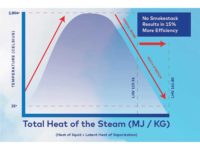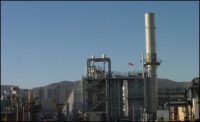Today’s boilers are experiencing continuing pollution control limits in the form of emissions reduction legislation. While the public, media, and policy environment often think of pollution control as a signal problem, most engineers understand emissions are a chain of complex problems. Boilers are used in many applications and, in general, provide either hot water or steam.
The primary products of combustion are carbon dioxide (CO2), water vapor (H2O), excess oxygen (O2), and nitrogen (N2), all generated from the exothermic reaction. Trace compounds or species also potentially generated in products of combustion are often measured in parts per million (ppm). Harmful pollutants include nitric oxide (NO), nitrogen dioxide (NO2), carbon monoxide (CO), sulfur dioxide (SO2), and other particulates.
The latest emission of CO2 (greenhouse gas) is gaining increased scrutiny for reduction. Renewable fuels offer a means to reduce the carbon footprint. This article will examine biogas, biodiesel, and hydrogen (H2).

Biogas (digester gas) is produced from various biomass sources through a biochemical process, such as anaerobic digestion, or through thermochemical gasification. This often ranges from low purity to high purity. Lower-purity ranges present challenges, such as low Btu per cubic foot content, hydrogen sulfide (H2S), and moisture. In general, burners without modification can operate with Btu per cubic foot values above a minimum of 550. Moisture causes two conditions of operation and material selection. If the biogas is above the hydrocarbon dew point, it remains a vapor and is considered to be dry. In this case, traditional materials may be used up to 1% (10,000 ppm) hydrogen sulfide. When the biogas is below the hydrocarbon dew point, the vapor condenses to a liquid. This changes material selection from traditional carbon steel and aluminum to stainless steel and different elastomers for corrosion resistance. Ideally, the digester gas will be conditioned with an H2S scrubber and a dryer upstream of the burner to ensure the digester gas is as clean and dry as possible, i.e., noncondensing. H2S must be treated with extreme care. Per OSHA, H2S at 0.001% (10 ppm) has an unpleasant odor and is safe for eight-hour exposure. It is extremely dangerous at 0.1% (1,000 ppm), where exposure will lead to immediate unconsciousness, followed by death within minutes.
Biodiesel fuel is available and already here with approved standards and infostructure. Biodiesel is domestically produced from vegetable oils, animal fats, and recycled restaurant grease. Soybean oil is currently a major feedstock for production of biodiesel. Biodiesel blends have current standards for B5 (5% biodiesel, 95% petroleum diesel) and B20 (20% biodiesel, 80% petroleum diesel) up to B100 (pure biodiesel). B20 is a common biodiesel blend in the U.S.
Power Flame Inc.’s burners are UL-listed for B20 operation. B20 operation will exhibit similar fuel consumption to that of fossil fuel. Using biodiesel reduces life cycle greenhouse gases by an average of 74% emissions, because CO2 released from biodiesel combustion is offset by the CO2 absorbed from growing soybeans or other feed stocks used to produce the fuel. UL standards exist today for B20 biodiesel. Material construction of the fuel train and burner require minor changes. In general, elastomers must be reviewed and proper selection is required. When the B100 standards are generated and released, further material selections will be necessary. Filtration is necessary as microbial growth can occur in any diesel fuel. Biodiesel is more susceptible, as it is made from plant and animal fats. Stagnant fuel is at higher risk. Biodiesel cold weather performance will require the use of fuel-line heaters or in-tank fuel heaters. Insulation will be required on outside equipment in cold environments.

Hydrogen, as the primary fuel, has had increased awareness as a method to reduce greenhouse gas emissions. There are many forms of hydrogen production. Currently, there is little “green” hydrogen production using only solar or wind to make electricity and electrolysis. Hydrogen’s largest obstacle is availability. Hydrogen has a low 325 Btu per cubic foot value, approximately one-third that of natural gas. Hydrogen’s ignition energy in air is among the lowest of all known fuels. Flammability limits are considerably different from natural gas. The lower flammability limit (LFL) for H2 is 4% volume in air, and the upper flammability limit (UFL) is 75% by volume in air. Natural gas has an LFL of 5% and UFL of 15%, typically. Hydrogen flames are difficult to see in daylight, presenting a hazard. Flame speed of H2 is 10 times that of natural gas at standard temperature and pressures. Burner heads (diffusers) will need to be redesigned to work the lighter, faster fuel. Leakage is another area of opportunity due to H2 being the smallest molecule on the periodic table.
The biggest opportunity for hydrogen, initially, until infrastructure is increased, is blending of hydrogen into natural gas. Blends offer a path forward as burners, piping, and other equipment will not require modification. Europe currently allows blending without modification up to 20% H2 and 80% natural gas. The country’s leaders may choose to go higher but likely will not exceed a 30% H2 and 70% natural gas mix.
The U.S. and Canada are in the process of defining such blend ratios. Above the limits set, material selection is important due to issues, such as hydrogen embrittlement. While 100% hydrogen offers no CO2 generation, methane (and then natural gas) are the cleanest of the hydrocarbon gases. A 500-BHP boiler firing on natural gas will produce under 2,500 pounds of mass per hour of CO2. While blending hydrogen with natural gas is a great alternative, it is not a one-for-one replacement for CO2 reduction. At 10% H2 and 90% NG, the CO2 reduction is approximately 3.4% less. At 20% H2 and 80% NG, the CO2 reduction is approximately 7.4% less. At 30% H2 and 70% NG, the CO2 reduction is approximately 12.0% less. Currently, Power Flame Inc.’s burners are capable of up to a 30% H2 blend.
The outlook of the future will be bright once the infrastructure is developed, and we have emission-free combustion when burning 100% H2 and 100% O2 generating an exothermic reaction that produces only dihydrogen monoxide.
David S. Neff, P.E., is director of engineering and research and development for Power Flame Inc.




